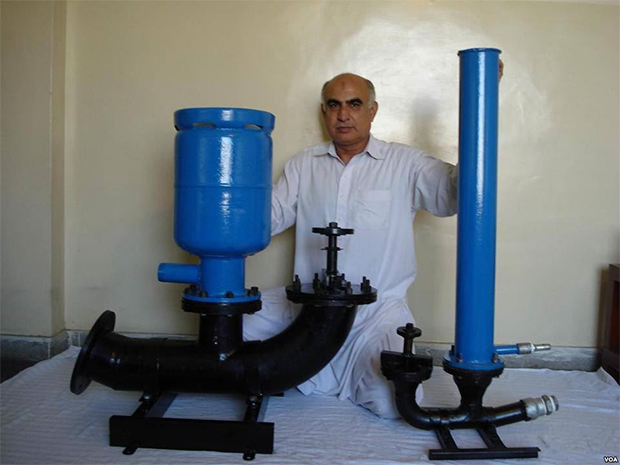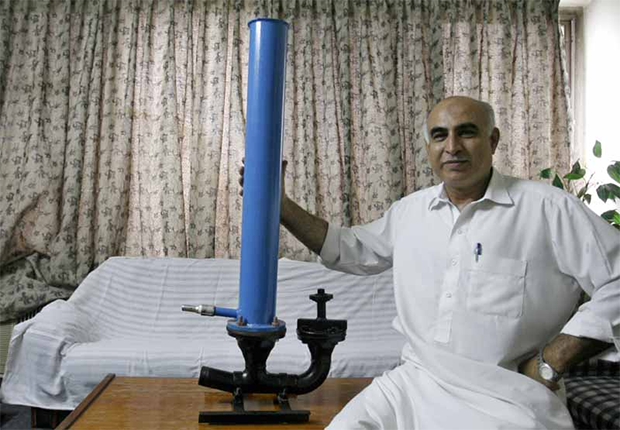|
A Pakistani engineer has developed a working model of the ram pump for
use in hilly areas to lift water from streams and other sources for
drinking and irrigation purposes.
Engineer Rehmatullah Kundi, who teaches at FAST National University of
Computer & Emerging Sciences, Peshawar, and belongs to Tank district of
Khyber Pakhtunkhwa province, told English daily ‘The News’ that the ram
pump, also known as the hydraulic ram, doesn’t use any electricity or
fuel and thus saves on high cost of energy.
“Its maintenance is minimal as it has only two moving parts. This
reduces the wear and tear of the machine. It is easy to operate. And it
operates seven days a week, 24 hours a day, year round,” he explained.
|
|
 |
|
Engineer Kundi said the pump requires as little as six-foot drive head
and can lift water up to 10 or more times the drive head. He said the
ram pump could be built in various sizes for both domestic and
agricultural use. The cost of a commercial design can vary from Rs25,000
to well over Rs50,000 depending on the capacity and lift required.
A prototype of the pump was installed on March 24, 2012 at Bada Khel
Hura near Jamrud in Khyber Agency in the country’s troubled Federally
Administered Tribal Areas. It has been running almost continuously for
more than three months in this hilly area.
According to Engineer Kundi, there is tremendous potential for the use
of such pumps in the hilly areas of Pakistan, particularly in Khyber
Pakhtunkhwa, Balochistan, Azad Kashmir and Gilgit-Baltistan.
“Unfortunately, it has not been pursued seriously, though there is some
evidence of the use of these pumps during the British era,” he said.
Kundi recalled that the ram pump was invented by John Whitehurst, an
Englishman, in 1775, and several years later a Frenchman Montgolfier and
his son Pierce Francois perfected the technology with additional
features.
“It is gaining popularity due to energy and environmental concerns. By
the end of the 20th century interest in hydraulic rams was revived due
to the needs of sustainable technology in developing countries, and
energy conservation in developed ones,” he said.
Engineer Kundi pointed out that a good example was AID Foundation
International in the Philippines that won an Ashden Award for its work
developing ram pumps that could be easily maintained for use in remote
villages.
|
|

|
|
Explaining the ram pump’s working, Kundi said: “The device uses the
water hammer effect to develop pressure that allows a portion of the
input water that powers the pump to be lifted to a point higher than
where the water originally started at virtually no running cost. Water
hammer effect is produced when the water flowing through a pipe is
suddenly brought to rest. This sudden change in momentum creates huge
amount of momentary pressure in the pipe. A cylinder captures this
pressure, which is then used to lift water. This is a cyclic operation
and repeats 30 to 60 times per minute.”
Engineer Kundi, who studied electrical engineering at the University of
Engineering and Technology, Peshawar, noted that building a working ram
pump was easy, but perfecting one that could work for many years with
little or no maintenance was a big challenge. He said the pump has to be
operated in remote areas where the cost of logistics is more than the
expenses on its installation.
“As the pump has to be rugged, reliable and easy to operate and the
local people should be able to maintain it without the need for special
equipment, I have also built a heavy-duty version,” he said.
The working of this pump could be seen at YouTube.
|
|
 |
|
Engineer Kundi, who did his MS (EE) from the University of Kansas, US,
is looking for sponsors for installation of the pump at suitable site
for public use so that the time-tested technology is introduced to parts
of the country where it is most needed.
“The data obtained from it will be used to build more efficient,
reliable and cost-effective ram pumps. There are plenty of water streams
in our hilly areas, but most people cannot take full advantage of such a
valuable resource due to the cost involved in lifting water. With this
technology, water resources could be harnessed for both domestic and
agricultural use at virtually no cost,” he argued. |